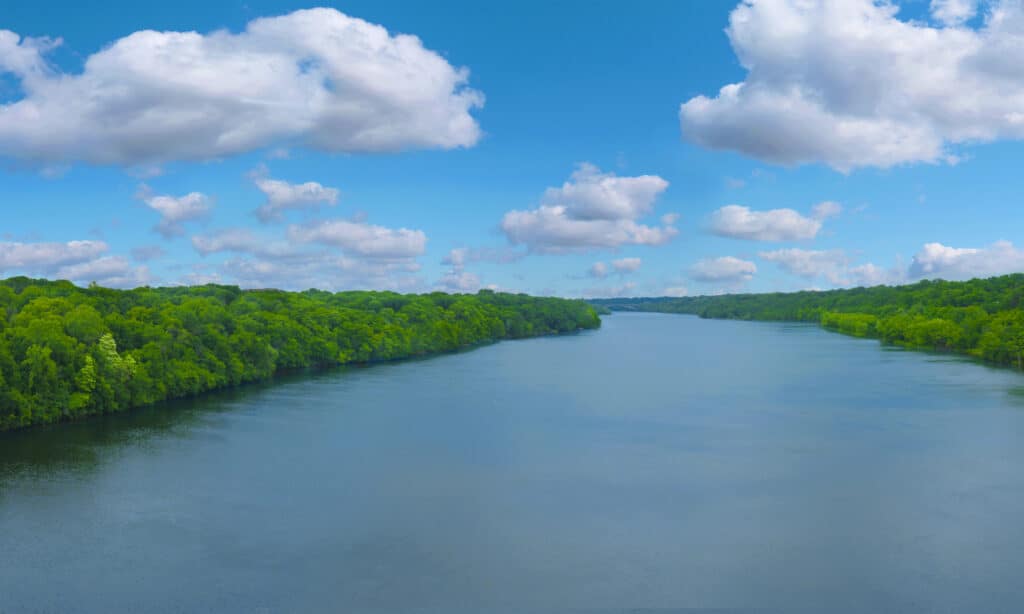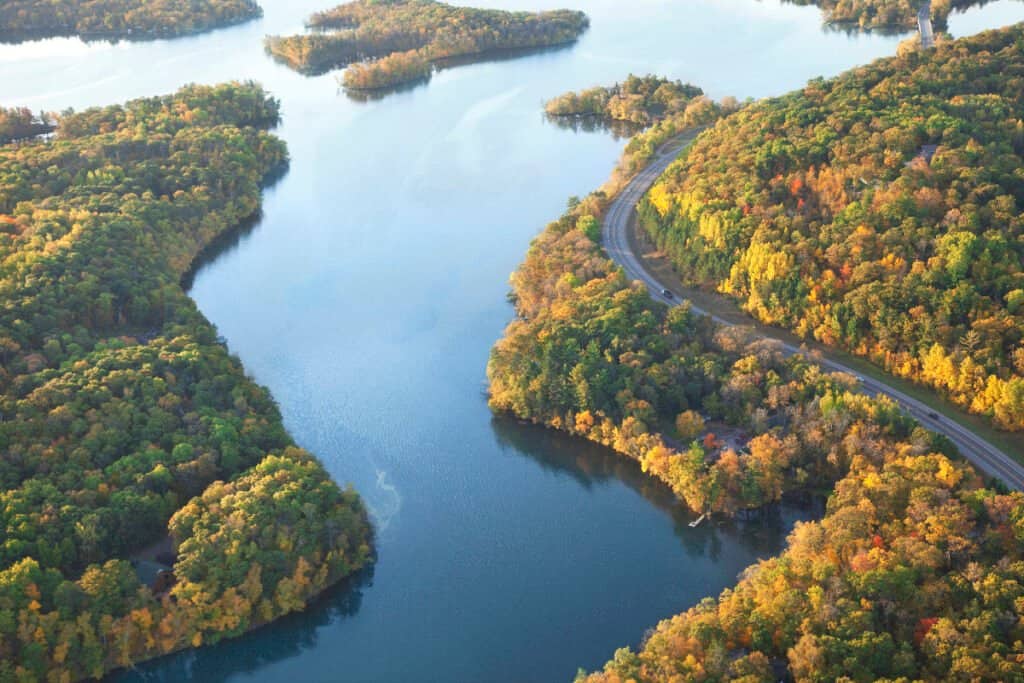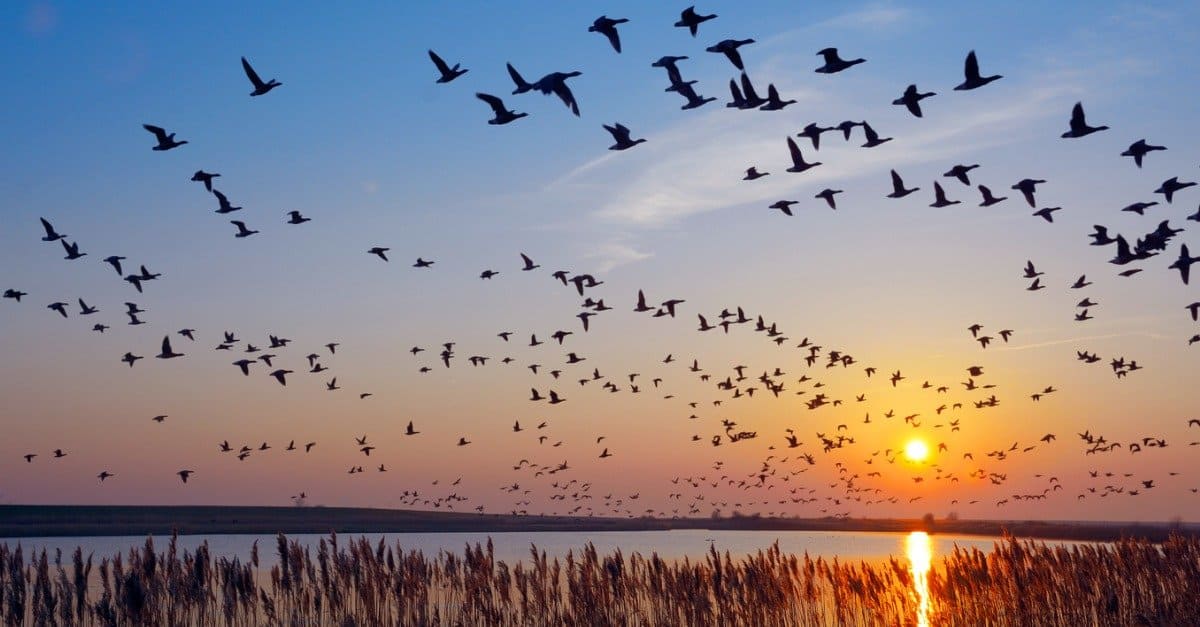The Mississippi River spans 2,350 miles (12,408,000 feet), flowing through Arkansas, Illinois, Iowa, Kentucky, Louisiana, Minnesota, Mississippi, Missouri, Tennessee, and Wisconsin. It is the second-longest river as well as the second-largest drainage system in North America.
Without the Mississippi, shipping would take more time and cost more on average. This is because the Mississippi is one of the largest water highways and supports the shipping industry with over 35,000 jobs.
This article takes a look at the river’s origin story – when and how the Mississippi came to be. Discover how the Mississippi River was formed below.
How Was The Mississippi River Formed?

The current form of the Mississippi River was largely shaped as a result of the Laurentide Ice Sheet of the last Ice Age.
©Milen Mkv/Shutterstock.com
The Mississippi River Basin’s current form was largely shaped as a result of the Laurentide Ice Sheet of the last Ice Age. Glaciers traveled over this area many times causing the top layers of the rock formations to be washed away. The glaciers melted, providing enough water to form the rivers.
When Was The Mississippi River Formed?

The Mississippi River is about 70 million years old.
©Sean Pavone/Shutterstock.com
It was previously believed that the Mississippi came into existence some 20 million years ago. However, in 2018, a team of SIU researchers led by Sally Potter-McIntyre discovered evidence to prove that the river is many times older than this.
Potter and her team discovered some zircon fragments from the river in Illinois. The age of the fragments allowed them to safely conclude that the Mississippi River is actually about 50 million years older; closer to 70 million years old.
Is The Mississippi River Natural Or Man-Made?

Human modifications made to the Mississippi no longer allow it to fit into the definition of a natural river.
©iStock.com/Willard
Although the river was created naturally as we have explained, humans have modified and tampered with it in many ways. A natural river is a natural watercourse that flows towards a sea, a lake, an ocean, or another river. The modifications carried out on the Mississippi River allow the river to suit our needs but change it in irreversible ways.
How Did Native Americans Cross The Mississippi?
The Native Americans traveled the Mississippi using boats. They followed paths through Mississippi, Arkansas, and Ohio Rivers.
Who First Explored The Mississippi River?
Jacques Marquette and Louis Jolliet are considered to be the first people to explore the Mississippi River and Valley. Jacques Marquette, who was a French explorer, was the first person recorded to have explored the Mississippi River. Louis Jolliet, on the other hand, was the first on record to explore the Mississippi Valley.
How Many People Have Swum The Entire Mississippi?
Only two people are recorded to have swum the Mississippi River. The first person to do it was Martin Strel. Strel is a Slovenian long-distance swimmer who achieved this feat in 2002.
The entire journey took him 68 days in a row. He started swimming on the 4th of July and ended his journey on the 9th of September- after he’d been swimming for a total of 68 days.
Three years later, in 2005, an American Navy Combat, Chris Ring, attempted the same feat. He was successful and became the first American and second person to swim the Mississippi. He completed his quest in 181 days.
The Mississippi River and Its Significance
For centuries, the Mississippi River has been relevant to Americans and the rest of the world for many reasons. Here are some of our favorites:
Mississippi Is Home to 25% of All Fish Species in North America
The northern parts of America are said to house more than 500 species of fish, 25% of which are found in the Mississippi alone. Mississippi’s upper parts contain 100 species of fish at least!
Mississippi Is A Water Source For 18 Million People
The Mississippi River provides water to millions of Americans. Minneapolis, Crystal, and New Hope cities, for example, get their water primarily from the Mississippi River. The water is taken from the river and moved to treatment plants.
In these treatment plants, the water is purified and made ready for consumption. It is then stored in a tank and passed to various homes through pipelines. Without the Mississippi, many cities would have water supply problems.
River Mississippi is The Birthplace of Water Skiing
In 1922, Ralph Samuelson invented water skiing on Lake Pepin. Lake Pepin is a naturally occurring lake located in the Mississippi River at the border between Minnesota and Wisconsin. Samuelson invented water skiing using a clothesline and a board for skis.
He tried out various positions until he figured out which position allowed him to maintain better balance. Ralph Samuelson found that the best way to avoid falling was to lean backward, allowing the tips of the board to stick out of the water.

It’s estimated that 60% of all North American birds use the Mississippi River Basin as their migratory flyway.
©eurotravel/Shutterstock.com
Mississippi River Is Considered One of the Major Migratory Flyways for Birds
The National Park Service Government states that 60% of all North American birds (326 species) use the Mississippi River Basin as their migratory flyway. They also state that about 175 million tons of freight go past the Upper Mississippi River each year. This is done through the river’s system of 29 locks and dams.
The Mississippi River is a location for tourism in the United States. According to the National Wildlife Federation, tourism increases by at least 3 percent each year! People visit the Upper Mississippi for a plethora of reasons including recreation, tourism, and even work. An approximated 12 million people visit for recreation each year.
Final Words
The Mississippi River is also called The Great River, hinting at its importance to America and the world. Considering the fact that the river is as old as dinosaurs, it needs all the help we can offer it to retain its natural features.
One way you can help preserve the Mississippi is by planting native species and being on the lookout for invasive ones. Pollution is another major problem that the Mississippi and all rivers face, so if you have a little time to spare, volunteer at your local river management center and do a little to reduce your impact on nature.
Thank you for reading! Have some feedback for us? Contact the AZ Animals editorial team.








